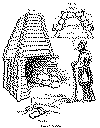By Dan Beard
To provide one of these useful adjuncts fitted for
A Winter Camp,
one will do well to take a hint from the homely architects of the picturesque log houses which dot the mountains in the "moon shine" districts of the Southern States, where the cabins are almost universally supplied with a simple fireplace built of stones on the outside of the house, and surmounted by it "stick" chimney; that is, a flue built with small sticks laid in the same way as the logs which compose the walls of the house, but, unlike the latter, the sticks decrease in size as they approach the top. The stick chimneys are liberally daubed with clay, which dries and is hardened by the heat from the fire below. With a few unimportant changes in the "moonshine" plan,
A Dixie
may be made to heat a log lodge, built on a modification of the ones invented by the Indians. Figs. 434, 435 and 436 show the details of the construction of the Dixie. Fig. 435 is it ground plan of the fireplace, which, as may be seen, is built by laying stones up against four posts and a number of sticks that have been firmly driven into the ground. The stories are laid so as to break joints. A thick coating of mud or clay will not only prevent the fire from cracking and crumbling the stones, but also help the chimney to draw up the smoke. It is, of course, understood by all who have built fires that the less side draughts, there are, the stronger is the current of air which ascends the chimney from the front, and the less liability is there to a smoky fireplace.
A glance at Fig. 434 shows that small logs have been used in the construction of the Dixie, in place of the small sticks of the moonshiner's cottage chimney. The logs make less work and require less skill than the stick chimney, besides giving the structure greater stability. The logs, however, should be plentifully coated with mud or clay, the same as the more dainty sticks. This is essential, not so much to prevent a conflagration, as to do away with leaks and insure a draught.
There is small danger from fire, otherwise the stick-chimney cabins of the South would all have been burned down long ago, in place of standing unharmed for years. There are cabins in the South today, with clay-daubed wooden flues, older than any of the readers of this book, and I have seen chimneys, made of unprotected flour barrels, which have been in constant use for many months. Fig. 436 shows the notches in the logs where they cross each other at the corners.
